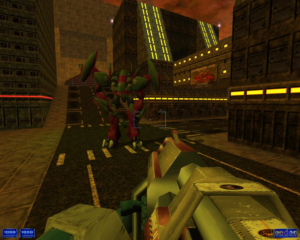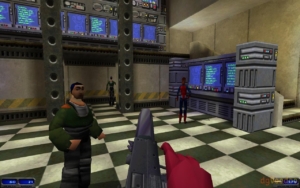Written by: Stoo
Date posted: September 22, 2020
I only played Shogo briefly back when it was released, actually I think it was probably a demo from PC Zone. It looked promising but for whatever reasons I never went back to it. I recall it was well received at the time; or at least hasty googling tells me that PC Zone gave it 92%. Still, it never had quite the same impact as Unreal or Half Life.
With its sci-fi setting, based around a battle on a distant world, Shogo’s key selling point is that you spend half the game piloting an anime-style mecha. It’s certainly an exciting prospect for any fans of enormous and heavily destructive robots. Shogo promises to let you stride around in a war machine twelve meters tall, carting around a gun the size of a lorry and unleashing prodigious amounts of firepower.
To some extent the implementation of this idea is successful, although you don’t really move like a thirty ton war machine. Instead you run with the same smooth gliding sprint that you do when on foot, or for that matter in every other 90s shooter. You also spin around with a flick of the mouse and leap nimbly into the air at the lightest tap of the space bar.
We should bar in mind, this isn’t meant to be a mechwarrior-style sim where the controls are a bit like driving mecha is a bit like driving a tank with feet, I suppose the question is how to make the player feek bulky and robotic while adhering to standard FPS conventions; I do think the running speed could at least have been dialled down a bit.
You do at least get a visual sense of scale. Several maps are based on futuristic city scapes, where streets are basically corridors to you, and you’re at eye level with about the fifth floor of tower blocks. Also, while enemy mecha are common threats, you face smaller and more mundane enemies to remind you how mighty you are. Regular tracked tanks are easy prey, trundling around your ankles. There are even infantry trying to bring you down, the poor bastards.
I was kind of wondering if I’d want to see more fine details – hot dog stands to tread on, panicking civilians to get in the way, apartment interiors to peer into like some sort of giant robot weirdo. However, I think this is unfair to ask of a 1998 game engine. It would be like asking a game on a regular human scale to render a building full of tiny objects and features. These were days of flat surfaces, blurry textures and a few boxy details. Within those confines, Shogo creates its world reasonably convincingly.
The part of “giant war robot” that Shogo definitely implements most successfully is the guns. Our starting weapon is essentially the plasma gun from Doom, shooting a hail of blue bolts. From here you get several kinds of railguns, laser and rocket launcher, all of which deliver the aforementioned colossal amounts of firepower. My favourite would be the bullgut which launches several rockets at once, each trailing smoke and fire. You can barely even see what’s happening, you just see a cluster of several explosions and assume your enemy has now been obliterated.
In keeping with the tradition of some of the finest giant robots, your mecha can transform into vehicle mode, more specifically some sort of armoured hovercraft. This seems marvelous at first, but it’s not actually all that useful. You have no weapons in this form, and while you’re notabily faster, only a few maps have the sort of open spaces where you can take advantage of that fact. In the city streets I spent most time in robot mode, where it’s plenty fast enough for the tight confines, and I could keep shooting all the way.
In the rest of the missions you’re out of the mecha and fighting on foot. At first I worried I’d find these sections to be a chore, since they remove the main feature meant to distinguish Shogo from all the other shooters. Yet actually, I realised they complement the mecha sections quite effectively.
On foot, you’re fighting through battles on a more personal scale. You’re running through offices and warehouses, places with mundane features like drains and vending machines. You’re armed with shotguns and assault rifles, shooting at regular grunts. It gives you a greater appreciation for your raw power as a mecha, where the small details of the world are beneath your notice, grunts are a minor nuisance and an office block is a piece of scenery you jump on to get a better vantage point
On both sides of the game, there’s an RPG-style system of critical hits that do extra damage to your target. You also get a health boost every time this occurs, and let’s not even try to rationalise this, it’s a novel feature at least. The bad news is that enemies can in turn score crits on you.
In fact when you start taking enemy fire, you can get shredded with frightening speed even on normal difficulty. Quite a few times I found myself dead before I had time to realise what had happened. That’s not to say the game is, overall, super tough, you just have to take care before blundering around the corner like some heavily armed oaf. In fact if you catch enemies at a distance you can often gun them down with ease, since they remain oblivious until you get closer. This somewhat uneven performance by your foes averages out at something that a seasoned gamer might blast through in a weekend.
Looking at the on-foot stuff again, it allows for early segment where you explore your base starship, mooch around the bar then get yelled at by your boss for showing up late. It should be a good time for a game to establish some background, and develop the characters. After all Shogo aims to tell a story, about a hero who has lost loved ones to war, and who gradually becomes less certain as to who the good guys are.
Unfortunately, I quickly lost track as to what the hell was going on. I had only a hazy grasp on who the various characters were, or what the two sides in this war were even fighting over. One or two events with great personal significance to Sanjuro completely failed to register in my brain. I’m shamefully reading through a fan wiki right now to catch up.
This concerns me, as I’d like to be able to give Shogo any credit it deserves. Integrating a narrative into a shooter, through dialogue and little cutscenes, was still a fairly new concept at the time. There had been brave efforts already, but just a couple of years earlier it had still been standard to just shoot your way to keys and an exit sign, or be given the most bare-bones plot and mission objectives.
I don’t know if the game should do more to sprinkle narrative and background through the missions, or if I just didn’t pay enough attention. I should just go ahead and confess I was playing in short bursts of half an hour here and there over the space of a several months, often while about to collapse asleep into bed (the life of a dad gamer). Not the best way to retain information. This may mean I’m writing a terrible review here, so go ahead and apply for a refund of your subscription fee.
(Still it doesn’t help that the dialogue is too quiet and sometimes lacks subtitles.)
As a final remark, there are other anime-inspired details alongside the mecha, such as the art style of portraits that pop up in dialogue, or the intro sequence complete with cheery theme tune and vocals in Japanese. Anime is one part of geek culture I never got into but I can appreciate how it adds a bit of flavour not usually seen in PC games.
It’s inevitable that I conclude by comparing Shogo to Half Life, which Rik and I both believe to be the greatest shooter of this generation. Through use of story, scripting, level design and set-pieces, Valve had us totally immersed in Gordan Freeman’s bad day at the lab. Shogo, I’m afraid, is not quite on that level.
Still, I can see how it’s attempting to achieve something similar. It certainly provides some satisfying action, and while the Mecha stuff does not comprehensively change the nature of the shooter, it does add an original aspect to the proceedings. So if you’re revisiting late-90s shooters (or are a youngster encountering them for the first time, in which case, welcome!), then by all means play Half Life first. Afterwards, though, this one is certainly worth a go.




 Posts
Posts
In case anyone is wondering, the postal address for subscription refunds is the same one you use to claim prizes.
September 24, 2020 @ 9:27 am
I remember this review well. Steve Hill submitted his Half-Life review one day, I read it and submitted my Shogo review the next (having played a fair bit of HL in the meantime). True, Shogo wasn’t as good, and certainly hasn’t aged nearly as well, but that 92% was calculated to sit favourably beside Half-Life and I stand by it to this day. I freely admit, however, that my love for Shogo probably coloured my opinion of Blood 2 a little bit. I did rather enjoy the LithTech engine, though. Those arcs of spherical blood were quite something, and it was a super-fast engine.
March 10, 2021 @ 7:54 pm
I remember you were a big fan of this one Richie.
Have been thinking a lot about FPS games of this vintage recently.
Looking back at the 1999 Zone FPS Supertest, although everyone agreed that Half-Life was the best, there was absolutely no consensus on second place, with Quake II somehow finishing runner up… Plus Unreal and Klingon Honor Guard came in for a lot of stick!
I think this would have been my second choice too. Hoping to revisit one or two of the other late 90s crop soon.
March 11, 2021 @ 3:48 pm
I could never get into Unreal. Bored me to tears. Mind you, Quake II SP got repetitive real quick. It probably did well due to the MP. We were playing it rather a lot at the time.
Ooh, another LithTech classic – NOLF.
March 11, 2021 @ 9:44 pm
I think I’d put this one a little behind Half Life, Sin also good, the same sort of attempts at narrative and actual events happening (instead of running and gunning through a map)
Then Unreal, which never had much of a plot but it was pretty at least. Quake 2 was drab and uninspiring, but I can only comment on singleplayer.
As for Blood 2, I wrote about it eons ago but would really have to play again to update my thoughts.
March 12, 2021 @ 11:46 am